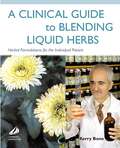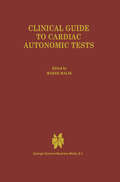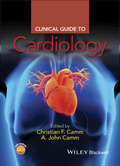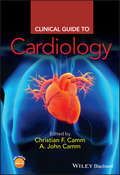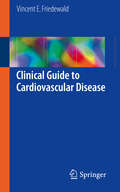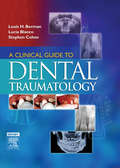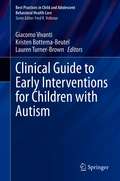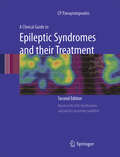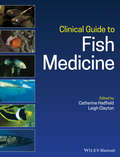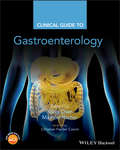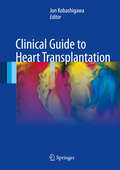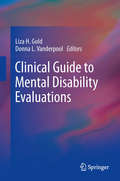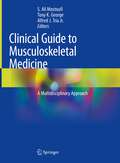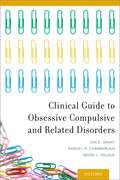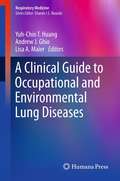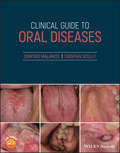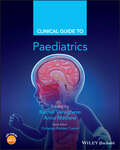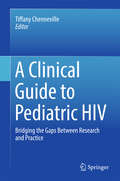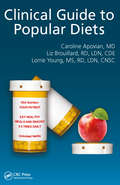- Table View
- List View
A Clinical Guide to Blending Liquid Herbs E-Book: Herbal Formulations for the Individual Patient
by Kerry BoneThis clinical guide and practical reference is ideal for those who use and combine liquid herbal remedies for the individual needs of the patient. With three introductory chapters, 125 monographs, and various glossaries and appendices, it covers the fundamental concepts of using liquid herbals, including how the remedies are made, quality issues, and dosage guidelines. The monographs include full prescribing information that covers actions, indications, contraindications, warnings and precautions, interactions, side effects, dosage, traditional usage, pharmacological research, clinical studies, and full references.Focuses solely on liquid herbal preparations — making it a must-have resource and the only book of its kind.Covers approximately 125 herb profiles in detail.Offers the widest range of research-backed information currently available on herbs.Begins with basic principles to give practitioners confidence in the accuracy and precision of their prescriptions.Written by one of the leading names in herbal medicine.Clinically relevant with quick access to dosage information, contraindications, and more.
Clinical Guide to Cardiac Autonomic Tests
by MarekMalikFollowing systematic development of technical aspects and physiological understanding, and clinical applicability of cardiac autonomic testing, this book provides a detailed guide to performing individual autonomic tests in both research and clinical settings. The book is structured in three parts covering the physiological background of cardiac autonomic regulations, description of technology and interpretation of individual autonomic tests, and applicability of the individual tests under various clinical circumstances and in defined populations of patients. The book is intended to serve both research and clinical cardiologists as well as research and clinical specialists of other medical fields who use the assessment of cardiac modulations to investigate the autonomic nervous system.
Clinical Guide to Cardiology (Clinical Guides)
by Christian F. Camm A. John CammClinical Guide to Cardiology is a quick-reference resource, packed full of bullet points, diagrams, tables and algorithms for the key concepts and facts for important presentations and conditions within cardiology. It provides practical, evidence-based information on interventions, investigations, and the management of clinical cardiology. Key features include: A clear evidence-base providing key guidelines and clinical trials in each chapter Coverage of examination techniques, common conditions, imaging modalities (including ECGs, chest X-rays, MRI and CT), interventional therapies, and pharmacology A companion website at www.wiley.com/go/camm/cardiology featuring audio clips, developed for differing levels of knowledge, that explain key concepts or an area in greater detail, as well as numerous additional clinical case studies, audio scripts, and self-assessment material
Clinical Guide to Cardiology (Clinical Guides)
by Christian F. Camm John A. CammClinical Guide to Cardiology is a quick-reference resource, packed full of bullet points, diagrams, tables and algorithms for the key concepts and facts for important presentations and conditions within cardiology. It provides practical, evidence-based information on interventions, investigations, and the management of clinical cardiology. Key features include: A clear evidence-base providing key guidelines and clinical trials in each chapter Coverage of examination techniques, common conditions, imaging modalities (including ECGs, chest X-rays, MRI and CT), interventional therapies, and pharmacology A companion website at www.wiley.com/go/camm/cardiology featuring audio clips, developed for differing levels of knowledge, that explain key concepts or an area in greater detail, as well as numerous additional clinical case studies, audio scripts, and self-assessment material
A Clinical Guide to Dental Traumatology - E-Book
by Louis H. Berman Lucia Blanco Stephen CohenThis practical, highly illustrated book describes the treatment and management of commonly encountered traumatic injuries to the teeth. It relates these types of trauma to crown fractures, root fractures, luxation injuries, and exarticulations. A step-by-step reference, this book also discusses complications that may involve surrounding soft and hard tissues, plus those that may arise in managing medically compromised patients.Hundreds of full-color photographs and illustrations show concepts and depict case studies and treatment outcomes.Step-by-step descriptions of treatment plans offer "recipes" for treating patients according to type of injury.For each type of traumatic injury, you'll learn these key steps:How to perform a correct initial assessment of the problem.How to determine whether the patient suffers any related problems.How to record the injury and its subsequent treatment in the patient record.How to avoid future problems by ensuring that the entire tooth is treated — including any hidden injury to the pulp or dentin.Information on etiology and epidemiology of problems promotes more effective treatment of specific injuries and conditions.The Law and Dental Trauma chapter explains legal issues unique to treating dental injuries under emergency conditions.Psychological Impact of Injuries chapter describes the reactions that trauma patients may have, and how dentists can improve treatment by providing the patient with emotional support and holistic management.Chapters on hard tissue injuries focus on injuries to tooth/hard tissue anatomy — and one chapter examines soft tissue management — discussing types of trauma and their effects on surrounding oral tissues.Introductory chapter provides an overview of topics discussed in the book.Hundreds of references are listed alphabetically at the end of each chapter with research studies and current articles for further research.An interdisciplinary approach includes periodontal, endodontic, and pediatric considerations for specific types of injuries.
Clinical Guide to Early Interventions for Children with Autism (Best Practices in Child and Adolescent Behavioral Health Care)
by Giacomo Vivanti Kristen Bottema-Beutel Lauren Turner-BrownThis book examines early interventions for children with autism spectrum disorder (ASD) with the goal to enable primary care physicians as well as other clinicians, therapists, and practitioners to assist parents in making informed decisions based on current research. It provides a map for successfully navigating the maze of early interventions for ASD, focusing on evidence. Chapters review the similarities and differences between current evidence-based treatments, how these treatments work, the factors that facilitate their effectiveness, and the pros and cons of their use for different children and different needs. In addition, chapters discuss the services, laws, policies, and societal issues related to early intervention in ASD. Featured topics include:Criteria to evaluate evidence in ASD interventions.Effective approaches for Social communication difficulties in ASD.Effective approaches for Restricted and repetitive behaviors (RRBs) in ASD.Naturalistic, developmental approaches to early intervention for children with ASDThe TEACCH approach and other visually based approaches for children with ASD.Applied Behavior Analysis (ABA) approaches to early intervention for children with ASD.What works for whom in ASD early intervention Clinical Guide to Early Interventions for Children with Autism is an essential resource for clinicians, primary care providers, and other practitioners as well as researchers, professors, and graduate students in the fields of child, school, and developmental psychology, pediatrics, social work, child and adolescent psychiatry, primary care medicine, and related disciplines.
A Clinical Guide to Epileptic Syndromes and their Treatment
by C. P. PanayiotopoulosAffecting 4 percent of children and 1-2 percent of the general population, epilepsy is one of the most common neurological disorders. The 1st edition of this guide proved to be the only one of its kind, covering many important aspects of diagnosis and treatment. Due to the continued advances being made in the subject, and building on the sell-out success of the 1st edition this thorough revision reflects the latest report of the ILAE classification core group and the significant progress made in the diagnosis, classification and treatment of the epilepsies.
Clinical Guide to Fish Medicine
by Catherine A. Hadfield Leigh Ann ClaytonClinical Guide to Fish Medicine Designed as a practical resource, Clinical Guide to Fish Medicine provides an evidence-based approach to the veterinary care of fish. This guide—written and edited by experts in the field—contains essential information on husbandry, diagnostics, and case management of bony and cartilaginous fish.This important resource:Provides clinically relevant information on topics such as anatomy, water quality, life-support systems, nutrition, behavioral training, clinical examination, clinical pathology, diagnostic imaging, necropsy techniques, anesthesia and analgesia, surgery, medical treatment, and transportDescribes common presenting problems of fish, including possible differentials and practical approachesReviews key information on non-infectious and infectious diseases of fish in a concise format that is easily accessible in a clinical settingWritten for veterinarians, biologists, technicians, specialists, and students, Clinical Guide to Fish Medicine offers a comprehensive review of veterinary medicine of fish.
Clinical Guide to Fish Medicine
by Catherine Hadfield Leigh ClaytonClinical Guide to Fish Medicine Designed as a practical resource, Clinical Guide to Fish Medicine provides an evidence-based approach to the veterinary care of fish. This guide—written and edited by experts in the field—contains essential information on husbandry, diagnostics, and case management of bony and cartilaginous fish.This important resource:Provides clinically relevant information on topics such as anatomy, water quality, life-support systems, nutrition, behavioral training, clinical examination, clinical pathology, diagnostic imaging, necropsy techniques, anesthesia and analgesia, surgery, medical treatment, and transportDescribes common presenting problems of fish, including possible differentials and practical approachesReviews key information on non-infectious and infectious diseases of fish in a concise format that is easily accessible in a clinical settingWritten for veterinarians, biologists, technicians, specialists, and students, Clinical Guide to Fish Medicine offers a comprehensive review of veterinary medicine of fish.
Clinical Guide to Gastroenterology (Clinical Guides)
by Christian Fielder CammClinical Guide to Gastroenterology is an accessible, quick-reference resource that provides practical, evidence-based information on investigations, interventions and management of clinical gastroenterological scenarios. It is packed full with bullet points, diagrams, tables, and algorithms of the important presentations and conditions within Clinical Gastroenterology. Divided into sections, the book offers in-depth coverage of presenting complaints in Gastroenterology, common conditions broken down by organ system, important investigations and procedures, and pharmacology. Detail is given to the sequence of clinical examination, investigations and management required to diagnose and treat a wide range of gastroenterological disorders. Provides information on symptoms, disorders and issues found in the clinical environment Guides readers in decision-making, appropriate investigation, and conducting interventions Includes important guidelines and clinical trials within each chapter Supplemented by a companion website featuring a wealth of additional material, including more than 70 audio clips, over 50 clinical case studies, and almost 350 self-assessment questions, as well as key clinical trials and guidelines Clinical Guide to Gastroenterology is a must-have text for junior doctors and medical students as well as doctors, nurses and trainees working within Emergency Departments, Medical, or Surgical Assessment Units.
Clinical Guide to Gastroenterology (Clinical Guides)
by Christian Fielder CammClinical Guide to Gastroenterology is an accessible, quick-reference resource that provides practical, evidence-based information on investigations, interventions and management of clinical gastroenterological scenarios. It is packed full with bullet points, diagrams, tables, and algorithms of the important presentations and conditions within Clinical Gastroenterology. Divided into sections, the book offers in-depth coverage of presenting complaints in Gastroenterology, common conditions broken down by organ system, important investigations and procedures, and pharmacology. Detail is given to the sequence of clinical examination, investigations and management required to diagnose and treat a wide range of gastroenterological disorders. Provides information on symptoms, disorders and issues found in the clinical environment Guides readers in decision-making, appropriate investigation, and conducting interventions Includes important guidelines and clinical trials within each chapter Supplemented by a companion website featuring a wealth of additional material, including more than 70 audio clips, over 50 clinical case studies, and almost 350 self-assessment questions, as well as key clinical trials and guidelines Clinical Guide to Gastroenterology is a must-have text for junior doctors and medical students as well as doctors, nurses and trainees working within Emergency Departments, Medical, or Surgical Assessment Units.
Clinical Guide to Heart Transplantation
by Jon KobashigawaThis is a concise review of up-to-date concepts and techniques in the discipline of heart transplantation. It is a review and reference for practitioners managing patients with advanced heart disease, including patients with end-stage heart failure, mechanical circulatory support or transplant recipients. Heart failure is a major public health issue, with a prevalence of over 5.8 million in the USA, and over 23 million worldwide, and rising. The lifetime risk of developing heart failure is one in five. Heart failure carries substantial morbidity and mortality, with 5-year mortality that rival those of many cancers. As heart transplantation remains the best treatment option for patients with end stage heart failure, this primer will provide valuable information and management strategies for physicians caring for these patients. Also, due to continued shortage in donor organs, heart transplantation is a limited resource – which further underscores the importance of appropriately evaluating patients for transplant candidacy and managing their pre, peri- and post-transplant care for maximum benefit and best outcomes.
Clinical Guide to Mental Disability Evaluations
by Liza H. Gold and Donna L. VanderpoolDisability evaluations are the most common clinical mental health evaluations conducted for nontreatment purposes. They place mental health professionals in the role of communicating information that is typically confidential to administrative and legal systems. Unfortunately, mental health professionals receive little to no training in conducting assessments that focus on disability and disability management, and often do not understand the implications and risks of providing this information, especially without conducting what are often specialized evaluations. Clinical Guide to Mental Health Disability Evaluations is geared for general mental health practitioners, providing them with the basic information needed to competently provide the various types of disability evaluations. It also provides enough information to inform forensic mental health providers in conducting more specialized evaluations.
Clinical Guide to Musculoskeletal Medicine: A Multidisciplinary Approach
by S. Ali Mostoufi Tony K. George Alfred J. Tria Jr.This unique clinical guide will explore specific evidence-based literature supporting physical therapist guided exercises and interventional treatments for commonly prevalent orthopedic spine and extremity presentations. Using this book, the sports medicine and interventional pain physician will be better able to coordinate therapy exercises after interventional treatments with their physical therapy colleagues. This will include a treatment course that will monitor progress in restoring and accelerating patients’ function. A myriad of musculoskeletal conditions affecting the spine, joints and extremities will be presented, including tendinopathies, bursopathies, arthritis, fractures and dislocations - everything a clinician can expect to see in a thriving practice. Each chapter, co-authored by a physician and a physical therapist, will follow a consistent format for ease of accessibility and reference – introduction to the topic; diagnosis; medical, interventional, and surgical management – and will be accompanied by relevant radiographis, figures and illustrations. Additional topics include osteoarthritis, rheumatic disorders, entrapment syndromes, the use of orthobiologics, and more. Comprehensive enough to function as a learning tool, but practical and user-friendly enough for quick reference, Clinical Guide to Musculoskeletal Medicine will be an essential resource for sports medicine physicians, interventional and physical therapists.
Clinical Guide to Obsessive Compulsive and Related Disorders
by Jon E. Grant Samuel R. Chamberlain Brian L. OdlaugClinical Guide to Obsessive Compulsive and Related Disorders is a complete, comprehensive overview of OCD and related disorders (trichotillomania, excoriation disorder, hoarding disorder, body dysmorphic disorder, and tic disorders). The book covers underlying causes, clinical presentations and treatments. The book serves as a primer for clinicians in training and those already in practice who have little if any background in these disorders. It discusses the pharmacological and psychosocial treatments for both adults and children with an emphasis on providing practical information for clinicians to use in their everyday practices. Based on the DSM-5, the book uses the latest evidence-based information regarding treatments including medication options, behavioral therapies, alternative treatments, and recent developments in surgical treatment. This book will provide students, residents, interns and even veteran clinicians with a basic understanding of OCD and disorders that are often associated with OCD. In addition, members of the public and those affected by these disorders may use this book to enhance their personal knowledge of the subject matter presented.
Clinical Guide to Obsessive Compulsive and Related Disorders
by Jon E. Grant Brian L. Odlaug Samuel R. ChamberlainClinical Guide to Obsessive Compulsive and Related Disorders is a complete, comprehensive overview of OCD and related disorders (trichotillomania, excoriation disorder, hoarding disorder, body dysmorphic disorder, and tic disorders). The book covers underlying causes, clinical presentations and treatments. The book serves as a primer for clinicians in training and those already in practice who have little if any background in these disorders. It discusses the pharmacological and psychosocial treatments for both adults and children with an emphasis on providing practical information for clinicians to use in their everyday practices. Based on the DSM-5, the book uses the latest evidence-based information regarding treatments including medication options, behavioral therapies, alternative treatments, and recent developments in surgical treatment. This book will provide students, residents, interns and even veteran clinicians with a basic understanding of OCD and disorders that are often associated with OCD. In addition, members of the public and those affected by these disorders may use this book to enhance their personal knowledge of the subject matter presented.
A Clinical Guide to Occupational and Environmental Lung Diseases (Respiratory Medicine)
by Yuh-Chin T. Huang, Andrew J. Ghio and Lisa A. MaierA Clinical Guide to Occupational and Environmental Lung Diseases delivers a concise compendium to the diagnosis and management of occupational and environmental lung diseases, incorporating evidence-based guidelines where available. Each chapter provides an updated review and a practical approach to different occupational and environmental lung diseases. With rapidly changing technology, new conditions and exposures will undoubtedly emerge. Clinicians need to remain vigilant about assessing the potential link between lung diseases and environmental exposures, and this book provides a practical guide to recognize, diagnose, and prevent occupational and environmental lung diseases. Written for practicing clinicians including internists, pulmonologists, and primary care providers, as well as industrial hygienists and environmental regulators, A Clinical Guide to Occupational and Environmental Lung Diseases is a timely and important new volume and an invaluable contribution to the literature.
Clinical Guide to Oral Diseases
by Dimitris Malamos Crispian ScullyA quick reference and revision guide on the most common oral and perioral diseases seen in clinical practice Clinical Guide to Oral Diseases is a concise reference on the common diseases encountered in daily practice. Presenting a large selection of clinical cases, this user-friendly resource covers a range of oral and perioral lesions located in hard and soft tissues of the mouth and neck, as well as oral manifestations of various systemic diseases. Nearly 300 high-quality color images complement succinct descriptions of clinical cases seen in both community and hospital care settings. Divided into three parts, the text first covers oral lesions classified by their color, appearance, and symptomatology such as bleeding, disturbances of saliva, taste, and orofacial pain. Part two describes the most common oral lesions by location, including those in the buccal mucosae, floor of mouth, gingivae and jaws, lips, neck, palate, salivary glands, tongue, and teeth. The third part encompasses oral lesions that are normal variations or those common to specific age groups or associated with various clinical phenomena. Provides nearly 300 high-quality clinical photos and relevant questions to help lead readers to the proper diagnosis of common oral diseases Contains concise tables relevant to each chapter with a list of common oral lesions and conditions Offers MCQs of varying levels of difficulty to help readers test their knowledge in Oral Medicine Includes clinical flow charts according to the location and duration of oral lesions Incorporates the ICD-10 Codes of oral lesions and diseases Clinical Guide to Oral Diseases is a valuable reference for general dental and medical practitioners, undergraduate dental students, and postgraduate trainees in oral and maxillofacial surgery, oral medicine, oral pathology, periodontology as well as general pathology, dermatology or head and neck oncology.
Clinical Guide to Oral Diseases
by Dimitris Malamos Crispian ScullyA quick reference and revision guide on the most common oral and perioral diseases seen in clinical practice Clinical Guide to Oral Diseases is a concise reference on the common diseases encountered in daily practice. Presenting a large selection of clinical cases, this user-friendly resource covers a range of oral and perioral lesions located in hard and soft tissues of the mouth and neck, as well as oral manifestations of various systemic diseases. Nearly 300 high-quality color images complement succinct descriptions of clinical cases seen in both community and hospital care settings. Divided into three parts, the text first covers oral lesions classified by their color, appearance, and symptomatology such as bleeding, disturbances of saliva, taste, and orofacial pain. Part two describes the most common oral lesions by location, including those in the buccal mucosae, floor of mouth, gingivae and jaws, lips, neck, palate, salivary glands, tongue, and teeth. The third part encompasses oral lesions that are normal variations or those common to specific age groups or associated with various clinical phenomena. Provides nearly 300 high-quality clinical photos and relevant questions to help lead readers to the proper diagnosis of common oral diseases Contains concise tables relevant to each chapter with a list of common oral lesions and conditions Offers MCQs of varying levels of difficulty to help readers test their knowledge in Oral Medicine Includes clinical flow charts according to the location and duration of oral lesions Incorporates the ICD-10 Codes of oral lesions and diseases Clinical Guide to Oral Diseases is a valuable reference for general dental and medical practitioners, undergraduate dental students, and postgraduate trainees in oral and maxillofacial surgery, oral medicine, oral pathology, periodontology as well as general pathology, dermatology or head and neck oncology.
Clinical Guide to Paediatrics (Clinical Guides)
by Christian Fielder CammClinical Guide to Paediatrics enables rapid reference to the common paediatric conditions, symptoms, and practical concerns seen in day-to-day practice. Focused on making differential diagnoses in acute settings, this comprehensive resource offers step-by-step guidance on clinical decision-making, investigations, and interventions. Junior doctors and medical students are provided with a clear and up-to-date evidence base supported by numerous diagnostic algorithms, diagrams, tables and bullet points throughout. Organised into systems-based sections, the guide covers paediatric history taking, examination techniques, pharmacology, safeguarding, and a range of different diagnoses for presenting complaints in cardiology, infection and immunology, neurology, gastroenterology, accidents, poisoning, and more. Succinct chapters are logically structured to allow easy access to important concepts, key clinical details, and plans of investigation. Designed to complement the doctor-patient interaction in clinical practice, this valuable guide: Covers the most common presenting complaints encountered in acute paediatrics Provides evidence-based information on symptoms, disorders, and issues faced in paediatric medicine Addresses topics from the perspective of presenting complaints to provide a unique, highly practical approach to the subject Includes access to a companion website containing images and clinical photos, audio podcasts, clinical case studies, and self-assessment exercises Clinical Guide to Paediatrics is essential reading for junior doctors, medical students, nurses and specialist trainees working on paediatric wards or emergency departments.
Clinical Guide to Paediatrics (Clinical Guides)
by Christian Fielder CammClinical Guide to Paediatrics enables rapid reference to the common paediatric conditions, symptoms, and practical concerns seen in day-to-day practice. Focused on making differential diagnoses in acute settings, this comprehensive resource offers step-by-step guidance on clinical decision-making, investigations, and interventions. Junior doctors and medical students are provided with a clear and up-to-date evidence base supported by numerous diagnostic algorithms, diagrams, tables and bullet points throughout. Organised into systems-based sections, the guide covers paediatric history taking, examination techniques, pharmacology, safeguarding, and a range of different diagnoses for presenting complaints in cardiology, infection and immunology, neurology, gastroenterology, accidents, poisoning, and more. Succinct chapters are logically structured to allow easy access to important concepts, key clinical details, and plans of investigation. Designed to complement the doctor-patient interaction in clinical practice, this valuable guide: Covers the most common presenting complaints encountered in acute paediatrics Provides evidence-based information on symptoms, disorders, and issues faced in paediatric medicine Addresses topics from the perspective of presenting complaints to provide a unique, highly practical approach to the subject Includes access to a companion website containing images and clinical photos, audio podcasts, clinical case studies, and self-assessment exercises Clinical Guide to Paediatrics is essential reading for junior doctors, medical students, nurses and specialist trainees working on paediatric wards or emergency departments.
A Clinical Guide to Pediatric HIV: Bridging the Gaps Between Research and Practice
by Tiffany ChennevilleThis book examines the impact of pediatric HIV on children, adolescents, and their families. Beginning with an overview of pediatric HIV epidemiology, it traces the medical, psychological, and social dimensions of HIV through the trajectory of childhood and youth. It examines the latest research on a wide range of topics, including treatment adherence, cultural, legal, and ethical issues, and HIV stigma and its reduction. Chapters offer expert recommendations for clinicians working with children with HIV as well as researchers studying pediatric HIV. In addition, the book also discusses daily concerns associated with pediatric HIV, such as disease management, coping, access to services, risk prevention, and health promotion. Topics featured in this book include: The impact of pediatric HIV on families. Psychosocial considerations for children and adolescents with HIV.HIV prevention and intervention in the school setting.HIV disclosure in pediatric populations.How to design effective evidence-based HIV risk-reduction programs for adolescents.A Clinical Guide to Pediatric HIV is a must-have resource for researchers, clinicians, and graduate students in child and school psychology, social work, and public health as well as pediatric medicine, nursing, epidemiology, anthropology, and other related disciplines.
Clinical Guide to Popular Diets
by Caroline Apovian Elizabeth Brouillard Lorraine YoungIt is no secret that the United States is facing an obesity epidemic with the obesity rates continuing to rise year after year. According to the Center for Disease Control, one third of Americans are now obese. It is no longer sufficient to simply point out the health risks of obesity to our patients as the reason to lose weight. Patients are seeking guidance in terms of what specific diet plan to follow and what foods should be eaten. There are thousands of diets on the market with new ones introduced daily. Not all diet plans have proven results, nor will they work for every patient. More importantly, not all diets marketed to the public are safe to follow for an extended timeframe. In fact, research shows us that diet composition is not the key to long term success, but compliance to a calorie deficient diet is the solution. So how does one choose which diet plan to recommend to patients? Finally, a book for clinicians is here to help answer this question. This book provides information to help patients understand several different research proven diets on the market today including: the Atkins diet, the DASH (Dietary Approaches to Stop Hypertension) diet, the I diet, the Mediterranean diet, Paleo Diets, South Beach, Vegetarian diets, Weight Watchers, and the Zone diet. Each diet is carefully and thoroughly reviewed in this book by some of America’s top obesity medicine and weight management specialists to provide health practitioners a knowledge of the diet composition, current research evaluating the diet, typical weight loss results, the pros and cons of the diet as well as which patients would most benefit from each diet plan. This book provides the necessary tools for clinicians to feel comfortable discussing several of the more popular and scientifically researched diets with patients. This book offers solid information to advise patients, based on their specific health history, on which diet will afford the greatest chance for success.
Clinical Guide to Popular Diets
by Caroline Apovian Elizabeth Brouillard Lorraine YoungIt is no secret that the United States is facing an obesity epidemic with the obesity rates continuing to rise year after year. According to the Center for Disease Control, one third of Americans are now obese. It is no longer sufficient to simply point out the health risks of obesity to our patients as the reason to lose weight. Patients are seeking guidance in terms of what specific diet plan to follow and what foods should be eaten. There are thousands of diets on the market with new ones introduced daily. Not all diet plans have proven results, nor will they work for every patient. More importantly, not all diets marketed to the public are safe to follow for an extended timeframe. In fact, research shows us that diet composition is not the key to long term success, but compliance to a calorie deficient diet is the solution. So how does one choose which diet plan to recommend to patients? Finally, a book for clinicians is here to help answer this question. This book provides information to help patients understand several different research proven diets on the market today including: the Atkins diet, the DASH (Dietary Approaches to Stop Hypertension) diet, the I diet, the Mediterranean diet, Paleo Diets, South Beach, Vegetarian diets, Weight Watchers, and the Zone diet. Each diet is carefully and thoroughly reviewed in this book by some of America’s top obesity medicine and weight management specialists to provide health practitioners a knowledge of the diet composition, current research evaluating the diet, typical weight loss results, the pros and cons of the diet as well as which patients would most benefit from each diet plan. This book provides the necessary tools for clinicians to feel comfortable discussing several of the more popular and scientifically researched diets with patients. This book offers solid information to advise patients, based on their specific health history, on which diet will afford the greatest chance for success.
